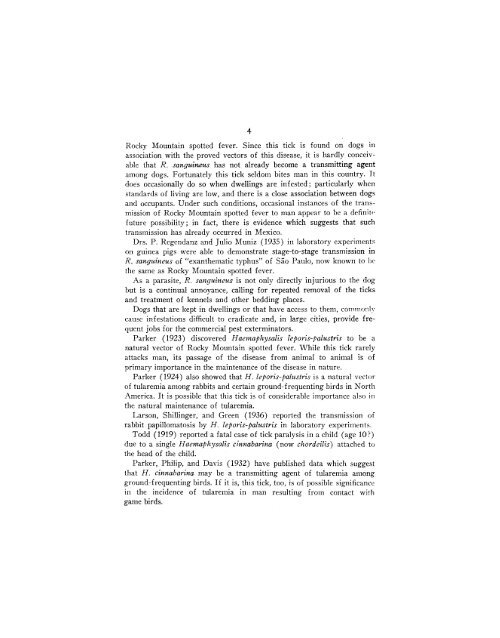The Genera Boophilus Rhipicephalus and Haemaphysalis (Ixodidae ...
The Genera Boophilus Rhipicephalus and Haemaphysalis (Ixodidae ...
The Genera Boophilus Rhipicephalus and Haemaphysalis (Ixodidae ...
You also want an ePaper? Increase the reach of your titles
YUMPU automatically turns print PDFs into web optimized ePapers that Google loves.
Mountain spotted fever. Since this tick is found on dogs in<br />
Rocky<br />
with the proved vectors of this disease, it is hardly conceiv-<br />
association<br />
that R. sangieus has not already become a<br />
transmitting agent<br />
able<br />
dogs. Fortunately this tick seldom bites man in this country. It<br />
among<br />
has already occurred in Mexico.<br />
transmission<br />
P. Regendanz <strong>and</strong> Julio Muniz (1935) in laboratory experiments<br />
Drs.<br />
guinea pigs were able to demonstrate stage-to-stage transmission in<br />
on<br />
sanguineus of "exanthematic typhus" of So Paulo, now known to be<br />
R.<br />
same as Rocky Mountain spotted fever.<br />
the<br />
a parasite, R. sanguineus is not only directly injurious to the dog<br />
As<br />
is a continual annoyance, calling for repeated removal of the ticks<br />
but<br />
treatment of kennels <strong>and</strong> other bedding places.<br />
<strong>and</strong><br />
that are kept in dwellings or that have access to them, commonly<br />
Dogs<br />
infestations difficult to eradicate <strong>and</strong>,-in large cities, provide fre-<br />
cause<br />
jobs for the commercial pest exterminators.<br />
quent<br />
(1923) discovered <strong>Haemaphysalis</strong> l'eporis-palustris to be a<br />
Parker<br />
man, its passage of the disease from animal to animal is of<br />
attacks<br />
importance in the maintenance of the disease in nature.<br />
primary<br />
(1924) also showed that H. leporis-palustris is a natural vector<br />
Parker<br />
tularemia among rabbits <strong>and</strong> certain ground-frequenting birds in North<br />
of<br />
natural maintenance of tularemia.<br />
the<br />
Shillinger, <strong>and</strong> Green (1936) reported the transmission of<br />
Larson,<br />
papillomatosis by H. leporis-palustris in laboratory experiments.<br />
rabbit<br />
(1919) reported a fatal case of tick paralysis in a child (age 107)<br />
Todd<br />
attached to<br />
head of the child.<br />
the<br />
Philip, <strong>and</strong> Davis (1932) have published data which suggest<br />
Parker,<br />
H. cinnabarina may be a transmitting agent of tularemia among<br />
that<br />
birds. If it is, this tick, too, is of possible significance<br />
ground-frequenting<br />
the incidence of tularemia in man resulting from contact with<br />
in<br />
birds.<br />
game<br />
4<br />
does occasionally do so when dwellings are infested;<br />
particularly when<br />
of living are low, <strong>and</strong> there is a close association between dogs<br />
st<strong>and</strong>ards<br />
occupants. Under such conditions, occasional instances of the trans-<br />
<strong>and</strong><br />
of Rocky Mountain spotted fever to man appear to be a<br />
definite'<br />
mission<br />
possibility; in fact, there is evidence which suggests that such<br />
future<br />
natural vector of Rocky Mountain spotted fever.<br />
While this tick rarely<br />
It is possible that this tick is of considerable importance also .in<br />
America.<br />
due to a single <strong>Haemaphysalis</strong> cinnabarina (now chordeilis)

















